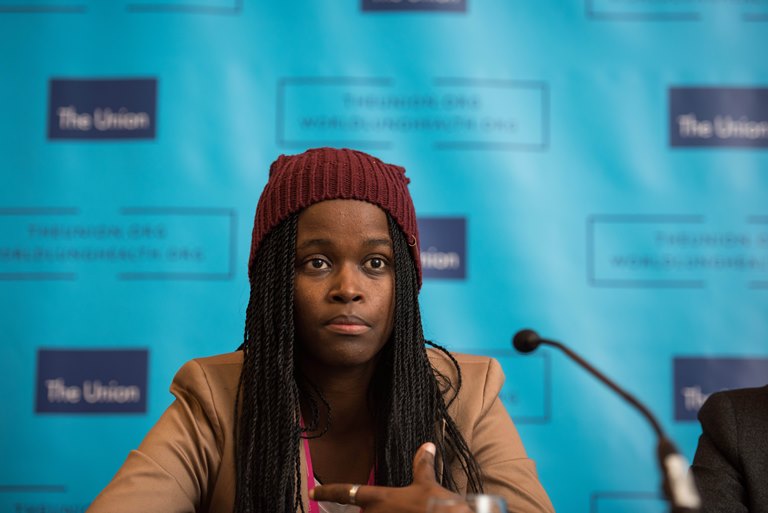This article originally appeared on the Women & Girls Hub of News Deeply, and you can find the original here. For important news about issues that affect women and girls in the developing world, you can sign up to the Women & Girls Hub email list.
By Sophie Cousins
Phumeza Tisile was 19 when she was diagnosed with a deadly, drug-resistant form of TB. Her experience of treatment and eventual survival turned her into an activist fighting for better access to treatment for others who face the same fate.
It was 2010 and South Africa was hosting the FIFA World Cup. Phumeza Tisile, who was 19 years old at the time and in her first year of university in Cape Town, was out celebrating with friends.
She had noticed that she had been getting thinner, but didn’t think anything of it until that day, when she tried to blow the vuvuzela – a blow horn that can be heard at most soccer games in South Africa. It was difficult. She couldn’t breathe.
Tisile went to her doctor and was diagnosed with “regular” tuberculosis (TB) and put on a six-month course of treatment.
But two months on, she seemed to be getting sicker. She eventually went back to the doctor, and further tests found she had a multi-drug-resistant form of TB, often referred to as MDR-TB.
TB, a contagious airborne disease, is the leading cause of death in South Africa, which has one of the highest incidences of the disease in the world. According to the latest figures from the World Health Organization (WHO), an estimated 450,000 new cases arise every year across the country. While more men than women are diagnosed with, and subsequently die of, TB, the disease can have particularly dire consequences for women of reproductive age. TB is one of the top five killers of women aged 20 to 59. If a pregnant woman contracts the disease, the risk of her pregnancy ending in perinatal death is six times higher, while the risk of premature birth and low birth weight increases twofold.
There is also a rising number of people, like Tisile, being diagnosed with drug-resistant strains of the illness. Most of these patients are resistant to at least two first-line drugs. Some people, known as extensively drug-resistant patients, are resistant to at least four of the core anti-TB medicines.
Dealing with patients who develop drug resistance can be very costly, as the specialist medicines needed are sometimes up to 200 times more expensive than normal TB treatments. The drugs are stronger and can have devastating side effects, including kidney impairment and depression.
Tisile was put on a drug regime for two years. “They put me on 20 tablets [a day],” she says. “I also had to have an injection every day for six months.”
But it wasn’t long before the medicines took a toll on Tisile, who ended up hospitalized for five months when she stopped being able to walk properly.
Furthermore, one day she woke up and noticed there was something else seriously wrong. She went to the bathroom, used the toilet and noticed she couldn’t hear it flushing. Then she turned on the tap to wash her hands, but again, there was no sound.
“I thought, ‘OK, maybe there’s something blocking my ears.’ I cleaned my ears but there was still no sound. People were moving their lips, but I couldn’t hear what they were saying,” she says.

A woman cuts the hair of a fellow tuberculosis patient at a clinic in the township of Khayelitsha, on the outskirts of Cape Town, South Africa. According to the WHO, the disease is one of the top five killers of women aged 20 to 59 years. (AP/Schalk van Zuydam)
What Tisile didn’t know, and hadn’t been told, was that hearing loss is a common side effect of the daily injections she was taking as part of her MDR-TB treatment. “When the doctor told me I was deaf, he also told me I was resistant to eight MDR-TB drugs,” she says. “I had been taking the wrong medication.”
Tisile was finally diagnosed with XDR-TB – the most severe form of TB, with little hope of survival.
The medicines made her feel even sicker. She was constantly in and out of hospital. An operation to remove TB from her lung resulted in a broken rib and a collapsed lung. By mid-2011, her XDR-TB treatment was no longer working.
Then medical staff from Doctors Without Borders (MSF) stumbled across her at a government clinic, and started her on an individually tailored XDR-TB regimen.
After two more years of treatment, she was told she had a 20 percent chance of survival.
“MSF told me that if I wanted to stop the medication all together, then I should and that I should consult a priest to prepare myself, because they didn’t see a way out of this one,” she says.
Against the odds, Tisile’s health finally started improving and, in August 2013, she was declared cured of XDR-TB.
After managing to raise $80,000 for a cochlear implant, Tisile regained her hearing in February 2015, almost five years after she lost it, and is excited to be restarting university next year to pursue gender studies.
Now she’s a fierce advocate for better access to testing and treatment for drug-resistant TB. She wants to see better, more affordable treatments with fewer side effects and a higher cure rate. And she is calling for the international community to fully fund the fight against the disease. “I could have died, and they don’t really know why I didn’t,” she says.
One of the drugs credited with helping cure Tisile is a high-strength antibiotic called linezolid. While the drug has shown promising results, it’s not widely available in South Africa due to its cost. It’s currently under patent and is not registered as a drug-resistant treatment in the country, making it difficult to access in public facilities.
Two new drugs for treating the most resistant forms of TB, bedaquiline and delamanid, have been developed since 2012 – the first new TB treatments in almost a century. But access remains severely limited due, again, to high cost and the fact that the drugs are registered in only a few countries. While the companies that produce them have set up limited donation programs, the cap on the number of treatment courses given is far below what’s required, and many high-burden countries are excluded from the deal.
“The world is just letting people with TB down,” Tisile says. “We know TB affects those who don’t have money. We need to raise awareness.”
Members of the World Health Assembly have committed to WHO’s End TB Strategy, which hopes to end the TB epidemic by 2035, reducing deaths by 95 percent and cutting new cases by 90 percent, with the ultimate goal of TB elimination as a public health problem by 2050.
But with the TB burden larger than previously thought, growing resistance and a massive gap in funding, experts are skeptical whether this goal is achievable.
Mick Frick, TB/HIV senior project officer at the Treatment Action Group, an independent think tank in South Africa, expressed concern at the decline in funding in the fight against TB, which he blames on a lack of investment by pharmaceutical companies and “anemic political will.”
“Meeting the innovation needs of the groups most affected by TB will be essential for ending the TB epidemic [but] these groups are being left behind,” he says.



